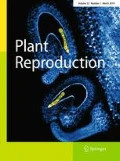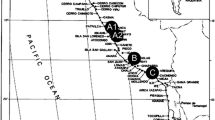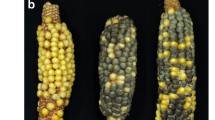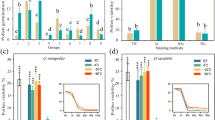Abstract
Nicotiana section Alatae contains eight species with variable flower sizes and morphologies. Section members readily hybridize in the glasshouse, but no hybrids have been observed in natural sympatric and parapatric populations. To investigate interspecific crossing relationships with respect to mechanisms preventing hybridization, all members of section Alatae were intercrossed in a complete diallel. We found positive correlation between the pistil length of the pollen donor and interspecific seed set relative to the conspecific cross. Pollen tube growth rate and pollen donor pistil length were positively correlated as well. Furthermore, pollen from short-pistil members of section Alatae could only grow a maximum distance proportional to, but greater than, their own pistil lengths. Our results show that pollen tube growth capacity (i.e., rate and distance), provides a hybridization barrier in long-pistil species × short-pistil species crosses. We also found another hybridization barrier not specifically related to pollen tube growth capacity in short-pistil species × long-pistil species. Taken together, these barriers can generally be described by a ‘pistil-length mismatch’ rule; in section Alatae, pollen has the most success fertilizing ovules from species with pistil lengths similar to their own. This rule could contribute to hybridization barriers in Section Alatae because the species display dramatically different pistil lengths.








Similar content being viewed by others
References
Alarcón R, Campbell DR (2000) Absence of conspecific pollen advantage in the dynamics of an Ipomopsis (Polemoniaceae) hybrid zone. Am J Bot 87:819–824
Arnold ML (1998) Natural hybridization and evolution. Oxford University Press, Oxford
Aronen T, Nikkanen T, Harju A, Tiimonen H, Haggman H (2002) Pollen competition and seed-siring success in Picea abies. Theor Appl Genet 104:638–642
Bertin RI, Peters PJ (1992) Parental effects on offspring quality in Campsis radicans. Am Nat 140:166–178
Brandvain Y, Haig D (2005) Divergent mating systems and parental conflict as a barrier to hybridization in flowering plants. Am Nat 166:330–338
Campbell DR, Alarcón R, Wu CA (2003) Reproductive isolation and hybrid pollen disadvantage in Ipomopsis. J Evol Biol 16:536–540
Carney SE, Cruzan MB, Arnold ML (1994) Reproductive interactions between hybridizing irises: analyses of pollen-tube growth and fertilization success. Am J Bot 81:1169–1175
Chase MW, Knapp S, Cox AV, Clarkson JJ, Butkso Y, Joseph J, Savolainen V, Parokonny AS (2003) Molecular systematics, GISH and the origin of hybrid taxa in Nicotiana (Solanaceae). Ann Bot 92:107–127
Cheung AY, Wu H-M, di Stilio V, Glaven R, Chen C, Wong E, Ogdahl J, Estavillo A (2000) Pollen-pistil interactions in Nicotiana tabacum. Ann Bot 85(Suppl A):29–37
Clarkson JJ, Kanpp S, Garcia VF, Olmstead RG, Leitch AR, Chase MW (2004) Phylogenetic relationships in Nicotiana (Solanaceae) inferred from multiple plastid DNA regions. Mol Phylogenet Evol 33:75–90
Cowan AA, Marshall AH, Michaelson-Yeates TPT (2000) Effect of pollen competition and stigmatic receptivity on seed set in white clover (Trifolium repens L.). Sex Plant Reprod 13:37–42
de Nettancourt D (1997) Incompatibility in angiosperms. Sex Plant Reprod 10:185–199
de Nettancourt D (2001) Incompatibility and incongruity in wild and cultivated plants. Springer, New York
Emms SK, Hodges SA, Arnold ML (1996) Pollen-tube competition, siring success, and consistent asymmetric hybridization in Louisiana irises. Evolution 50:2201–2206
Goldraij A, Kondo K, Lee CB, Hancock CN, Sivaguru M, Vazquez-Santana S, Kim S, Phillips TE, Cruz-Garcia F, McClure BA (2006) Compartmentalization of S-RNase and HT-B degradation in self-incompatible Nicotiana. Nature 439:805–810
Good-Avila SV, Nagel T, Vogler DW, Stephenson AG (2003) Effects of inbreeding on male function and self-fertility in the partially self-incompatible herb Campanula rapunculoides (Campanulaceae). A J Bot 90:1736–1745
Goodspeed T (1954) The genus Nicotiana. Chronica Botanica Company, Waltham
Grant V (1993) Origin of floral isolation between ornithophilous and sphingophilous plant species. Proc Natl Acad Sci USA 90:7729–7733
Grant V (1994) Modes and origins of mechanical and ethological isolation in angiosperms. Proc Natl Acad Sci USA 91:3–10
Hancock CN, Kondo K, Beecher B, McClure BA (2003) The S-locus and unilateral incompatibility. Philos Trans R Soc Lond B Biol Sci 358:1133–1140
Hauser TP, Jorgensen RB, Ostergard H (1997) Preferential exclusion of hybrids in mixed pollinations between oilseed rape (Brassica napus) and weedy B. campestris (Brassicaceae). Am J Bot 84:756–762
Herrero M, Hormaza JI (1996) Pistil strategies controlling pollen tube growth. Sex Plant Reprod 9:343–347
Higashiyama T, Kuroiwa H, Kawano S, Kuroiwa T (1998) Guidance in vitro of the pollen tube to the naked embryo sac of Torenia fournieri. Plant Cell 10:2019–2031
Hirose T, Ujihara A, Kitabayashi H, Minami M (1995) Pollen tube behavior related to self-incompatibility in interspecific crosses of Fagopyrum. Breed Sci 45:65–70
Hiscock SJ, Dickinson HG (1993) Unilateral incompatibility within the Brassicaceae: further evidence for the involvement of the self-incompatibility (S)-locus. Theor Appl Genet 86:744–753
Hiscock SJ, McInnis SM (2003) The diversity of self-incompatibility systems in flowering plants. Plant Biol 5:23–32
Hogenboom NG (1972) Breaking breeding barriers in Lycopersicon. The genus Lycopersicon, its breeding barriers and the importance of breaking these barriers. Euphytica 21:221–227
Hogenboom NG (1984) Incongruity: non-functioning of intercellular and intracellular partner relationships through non-matching information. In: Linskens HF, Heslop-Harrison J (eds) Encyclopedia of plant physiology, vol 17. Springer, New York, pp 640–654
Howard DJ (1999) Conspecific sperm and pollen precedence and speciation. Annu Rev Ecol Syst 30:109–132
Ippolito A (2000) Systematics, floral evolution and speciation in Nicotiana. Ph.D. dissertation, University of Missouri, Columbia
Ippolito A, Fernandes GW, Holtsford TP (2004) Pollinator preferences for Nicotiana alata, N. forgetiana, and their F 1 hybrids. Evolution 58:2634–2644
Jenkins TJ (1954) Interspecific and intergenic hybrids in herbage grasses. V. Lolium rigidum sens. ampl. with other Lolium species. J Genet 52:252–281
Johnston MO (1993) Tests of two hypotheses concerning pollen competition in a self-compatible, long styled species (Lobelia cardinalis: Lobeliaceae). Am J Bot 80:1400–1406
Kaczorowski R, Gardener MC, Holtsford TP (2005) Nectar traits in Nicotiana section Alatae (Solanaceae) in relation to floral traits, pollinators and mating system. Am J Bot 92:1270–1283
Kao TH, Tsukamoto T (2004) The molecular and genetic bases of S-RNase-based self-incompatibility. Plant Cell 16(Suppl):72–83
Kho YO, Baer J (1968) Observing pollen tubes by means of fluorescence. Euphytica 17:299–302
Lankinen A, Skogsmyr I (2001) Evolution of pistil length as a choice mechanism for pollen quality. Oikos 92:81–90
Legendre P, Lapointe FJ, Casgrain P (1994) Modeling brain evolution from behavior: a permutational regression approach. Evolution 48:1487–1499
Lewis D, Crowe L (1958) Unilateral interspecific incompatibility in flowering plants. Heredity 12:233–256
Lim KY, Kovarik A, Matyasek R, Chase MW, Knapp S, McCarthy E, Clarkson JJ, Leitch AR (2006) Comparative genomics and repetitive sequence divergence in the species of diploid Nicotiana section Alatae. Plant J 48:907–919
Liu SC, Liedl BE, Mutschler MA (1995) Alterations of the manifestations of hybrid breakdown in Lycopersicon esculentum L. pennellii F2 populations containing L. esculentum versus L. pennellii cytoplasm. Sex Plant Reprod 8:361–368
Lloyd DG (1968) Partial unilateral incompatibility in Leavenworthia (Cruciferae). Evolution 22:382–393
Lush MW, Clarke AE (1997) Observation of pollen tube growth in Nicotiana alata and their implications for the mechanism of self-incompatibility. Sex Plant Reprod 10:27–35
Martin FW (1961) Unilateral interspecific incompatibility in flowering plants. Heredity 12:233–256
Martin NH, Bouck AC, Arnold ML (2005) Loci affecting long-term hybrid survivorship in Louisiana irises: implications for reproductive isolation and introgression. Evolution 59:2116–2124
McClure BA, Haring V, Ebert PR, Anderson MA, Simpson RJ, Sakiyama F, Clark AE (1989) Style self-incompatibility gene products of Nicotiana alata are ribonucleases. Nature 342:955–957
McClure BA, Cruz-Garcia F, Beecher B, Sulaman W (2000.) Factors affecting inter- and intra-specific pollen rejection in Nicotiana. Ann Bot 85(Suppl A):113–123
Murfett J, Bourque JE, McClure BA (1995) Antisense suppression of S-RNase expression in Nicotiana using RNA polymerasae II- and III-transcribed gene constructs. Plant Mol Biol 29:201–212
Murfett J, Strabala TJ, Zurek DM, Mou B, Beecher B, McClure BA (1996) S-RNase and interspecific pollen rejection in the genus Nicotiana: multiple pollen-rejection pathways contribute to unilateral compatibility between self-incompatible and self-compatible species. Plant Cell 8:943–958
Niesesbaum RA, Schueller SK (1997) Effects of pollen competitive environment on pollen performance in Mirabilis jalapa (Nyctaginaceae). Sex Plant Reprod 10:101–106
Nikkanen T, Aronen T, Haggman H, Venalainen M (2000) Variation in pollen viability among Picea abies genotypes-potential for unequal paternal success. Theor Appl Genet 101:511–518
Nilsson LA (1983) Processes of isolation and introgressive interplay between Platanthera bifolia (L.) Rich. and P. chlorantha (Custer) Reichb. (Orchidaceae). Bot J Linn Soc 87:325–330
Onus AN, Pickersgill B (2004) Unilateral incompatibility in Capsicum (Solanaceae): occurrence and taxonomic distribution. Ann Bot 94:289–295
Pablo RJ, Germán SR, Lucila CE (2003) Crossability relationships among the wild diploid potato species Solanum kurtzianum, S. chacoense and S. ruiz-lealii from Argentina. Euphytica 132:287–295
Pandey KK (1973) Phases in the S-gene expression, and S-allele interaction in the control of interspecific incompatibility. Heredity 31:381–400
Pandey KK (1979) The genus Nicotiana: evolution of incompatibility in flowering plants. In: Hawkes JG, Lester RN, Skelding AD (eds) The biology and taxonomy of the Solanaceae. Academic, London
Perez S, Moore JN (1985) Prezygotic endogenous barriers to interspecific hybridization in Prunus. J Am Soc Hortic Sci 110:267–273
Rick CM (1963) Barriers to interbreeding in Lycopersicon peruvianum. Evolution 17:216–232
Rieseberg LH, Desrochers AM, Youn SJ (1995) Interspecific pollen competition as a reproductive barrier between sympatric species of Helianthus (Asteraceae). Am J Bot 82:515–519
Scribailo RW, Barret SCH (1991) Pollen-pistil interactions in tristylous Pontederia sagittata (Pontederiaceae). II. Patterns of pollen tube growth. Am J Bot 78:1662–1682
Skogsmyr I, Lankinen A (2000) Potential selection for female choice in Viola tricolor. Evol Ecol Res 2:965–979
Snow AA, Spira TP (1991) Differential pollen-tube growth rates and nonrandom fertilization in Hibiscus moscheutos (Malvaceae). Am J Bot 78:1419–1426
Snow AA, Spira TP (1996) Pollen-tube competition and male fitness in Hibiscus moscheutos. Evolution 50:1866–1870
Sorensson CT, Brewbaker JL (1994) Interspecific compatibility among 15 Leucaena species (Leguminosae: Mimosoideae) via artificial hybridizations. Am J Bot 81:240–247
Soule J (2007) Heterochrony of floral and mating system characters between Nicotiana longiflora and N. plumbaginifolia. Masters thesis, University of Missouri, Columbia
Stehmann JR, Semir J, Ippolito A (2002) Nicotiana mutabilis (Solanaceae), a new species from southern Brazil. Kew Bull 57:639–646
Vervaeke I, Parton E, Maene L, Deroose R, DeProft MP (2001) Prefertilization barriers between different Bromeliaceae. Euphytica 118:91–97
Vickery RK (1995) Speciation in Mimulus, or can a simple flower color mutant lead to species divergence. Great Basin Nat 55:177–180
Walsh NE, Charlesworth D (1992) Evolutionary interpretations of differences in pollen tube growth rates. Q Rev Biol 67:19–37
Wang J, Cruzan MB (1998) Interspecific mating in the Piriqueta caroliniana (Turneraceae) complex: effects of pollen load size and composition. Am J Bot 85:1172–1179
Williams EG, Rouse JL (1990) Relationships of pollen size, pistil length and pollen tube growth rates in Rhododendron and their influence on hybridization. Sex Plant Reprod 3:7–17
Williams JH Jr, Friedman WE, Arnold ML (1999) Developmental selection within the angiosperm style: using gamete DNA to visualize interspecific pollen competition. Proc Natl Acad Sci USA 96:9201–9206
Zinkl GM, Zweibel BI, Grier DG, Preuss D (1999) Pollen-stigma adhesion in Arabidopsis: a species-specific interaction mediated by lipophilic molecules in the pollen exine. Development 126:5431–5440
Acknowledgments
The authors thank Sherry Ellberg and Dr Rainee Kaczorowski for donation of plant materials. Helpful comments on preparation of the manuscript were provided by Dr Nathan Hancock and Dr Sunran Kim. This study was supported in part by a Life Sciences Fellowship from the University of Missouri, University of Missouri Research Board 97-033, and the US National Science Foundation grants IOB 0614962, DBI 0605200, and DEB 9727037. Any opinion, findings, conclusions, or recommendations expressed in this material are those of the authors and do not necessarily reflect the views of the National Science Foundation.
Author information
Authors and Affiliations
Corresponding author
Additional information
Communicated by Andrew Stephenson.
Electronic supplementary material
Below is the link to the electronic supplementary material.
Rights and permissions
About this article
Cite this article
Lee, C.B., Page, L.E., McClure, B.A. et al. Post-pollination hybridization barriers in Nicotiana section Alatae . Sex Plant Reprod 21, 183–195 (2008). https://doi.org/10.1007/s00497-008-0077-9
Received:
Accepted:
Published:
Issue Date:
DOI: https://doi.org/10.1007/s00497-008-0077-9




